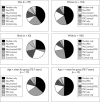Cataract surgery and subtype in a defined, older population: the SEECAT Project
- PMID: 15548802
- PMCID: PMC1772435
- DOI: 10.1136/bjo.2004.045484
Cataract surgery and subtype in a defined, older population: the SEECAT Project
Abstract
Aim: To describe the distribution of cataract subtypes present before surgery among a defined population of older, bilaterally pseudophakic individuals.
Methods: This was a cohort study of bilaterally pseudophakic individuals participating in the Salisbury Eye Evaluation (SEE), and their locally resident siblings. Subjects underwent slit lamp and retroillumination photography and grading using the Wilmer Cataract Grading System. For all individuals determined to be bilaterally pseudophakic, an attempt was made to determine for each eye the type(s) of cataract present before surgery, based on previous SEE photographs (for SEE participants) and/or medical records obtained from the operating ophthalmologist (for both SEE participants and their siblings).
Results: The mean age of 223 participants providing data in this study was 78.7 (SD 5.2) years, 19.3% of subjects were black and 60.1% female. The most common surgically removed cataract subtype in this population was pure nuclear (43.5%), followed by nuclear combined with posterior subcapsular cataract (PSC) (20.6%), and nuclear combined with cortical (13.9%); less common types were pure cortical (4.9%), pure PSC (4.5%), and PSC combined with cortical (2.7%). Factors such as sex and source of lens data (study photograph versus clinical record) did not significantly affect the distribution of lens opacity types, while PSC was significantly (p = 0.01) more common among younger people and nuclear cataract was significantly (p = 0.001) more common among white compared to black people.
Conclusion: Epidemiological studies have suggested that the different subtypes of cataract are associated with different risk factors. As studies begin to identify new prevention strategies for cataract, it would appear likely that different strategies will be efficacious against different types of cataract. In this setting, it will be helpful to know which cataract types are most frequently associated with surgery. Among this older, majority white population, nuclear cataract showed a clear predominance among individuals having undergone surgery in both eyes. This may be contrasted with both clinic and population based studies of younger people, which have generally found PSC cataract to predominate.
Figures





Similar articles
-
Racial differences in lens opacities: the Salisbury Eye Evaluation (SEE) project.Am J Epidemiol. 1998 Dec 1;148(11):1033-9. doi: 10.1093/oxfordjournals.aje.a009579. Am J Epidemiol. 1998. PMID: 9850124
-
Cortical, but not posterior subcapsular, cataract shows significant familial aggregation in an older population after adjustment for possible shared environmental factors.Ophthalmology. 2005 Jan;112(1):73-7. doi: 10.1016/j.ophtha.2004.07.012. Ophthalmology. 2005. PMID: 15629823 Free PMC article.
-
Prevalence of lens opacities in the Barbados Eye Study.Arch Ophthalmol. 1997 Jan;115(1):105-11. doi: 10.1001/archopht.1997.01100150107018. Arch Ophthalmol. 1997. PMID: 9006434
-
Prevalence and associations of cataract in a rural Chinese adult population: the Handan Eye Study.Graefes Arch Clin Exp Ophthalmol. 2013 Jan;251(1):203-12. doi: 10.1007/s00417-012-2012-x. Epub 2012 Apr 11. Graefes Arch Clin Exp Ophthalmol. 2013. PMID: 22527317
-
Incidence and progression of lens opacities in the Barbados Eye Studies.Ophthalmology. 2000 Jul;107(7):1267-73. doi: 10.1016/s0161-6420(00)00155-x. Ophthalmology. 2000. PMID: 10889096
Cited by
-
Polymorphisms of the WRN gene and DNA damage of peripheral lymphocytes in age-related cataract in a Han Chinese population.Age (Dordr). 2013 Dec;35(6):2435-44. doi: 10.1007/s11357-013-9512-4. Epub 2013 Jan 20. Age (Dordr). 2013. PMID: 23334603 Free PMC article.
-
Aggregation of lens crystallins in an in vivo hyperbaric oxygen guinea pig model of nuclear cataract: dynamic light-scattering and HPLC analysis.Invest Ophthalmol Vis Sci. 2005 Dec;46(12):4641-51. doi: 10.1167/iovs.05-0843. Invest Ophthalmol Vis Sci. 2005. PMID: 16303961 Free PMC article.
-
Diabetes and Cataracts Development-Characteristics, Subtypes and Predictive Modeling Using Machine Learning in Romanian Patients: A Cross-Sectional Study.Medicina (Kaunas). 2024 Dec 28;61(1):29. doi: 10.3390/medicina61010029. Medicina (Kaunas). 2024. PMID: 39859011 Free PMC article.
-
Cataract risk in US radiologic technologists assisting with fluoroscopically guided interventional procedures: a retrospective cohort study.Occup Environ Med. 2019 May;76(5):317-325. doi: 10.1136/oemed-2018-105360. Epub 2019 Mar 19. Occup Environ Med. 2019. PMID: 30890565 Free PMC article.
-
Risk Factors for Cataracts in Patients with Diabetes Mellitus.J Clin Med. 2024 Nov 21;13(23):7005. doi: 10.3390/jcm13237005. J Clin Med. 2024. PMID: 39685467 Free PMC article.
References
-
- Eye Disease Prevalence Research Group. Causes and prevalence of visual impairment among adults in the United States. Arch Ophthalmol. (in press). - PubMed
-
- Klein BEK, Klein R, Moss SE. Incident Cataract Surgery. Ophthalmology 1997;104:573–80. - PubMed
-
- Munoz B , West SK, Rubin GS, et al. Causes of blindness and visual impairment in a population of older Americans: the Salisbury Eye Evaluation Study. Arch Ophthalmol 2000;118:819–25. - PubMed
-
- Superstein R . Indications for cataract surgery. (Review) Curr Opin Ophthalmol 2001;12:58–62. - PubMed
Publication types
MeSH terms
Grants and funding
LinkOut - more resources
Full Text Sources
Medical
Research Materials
